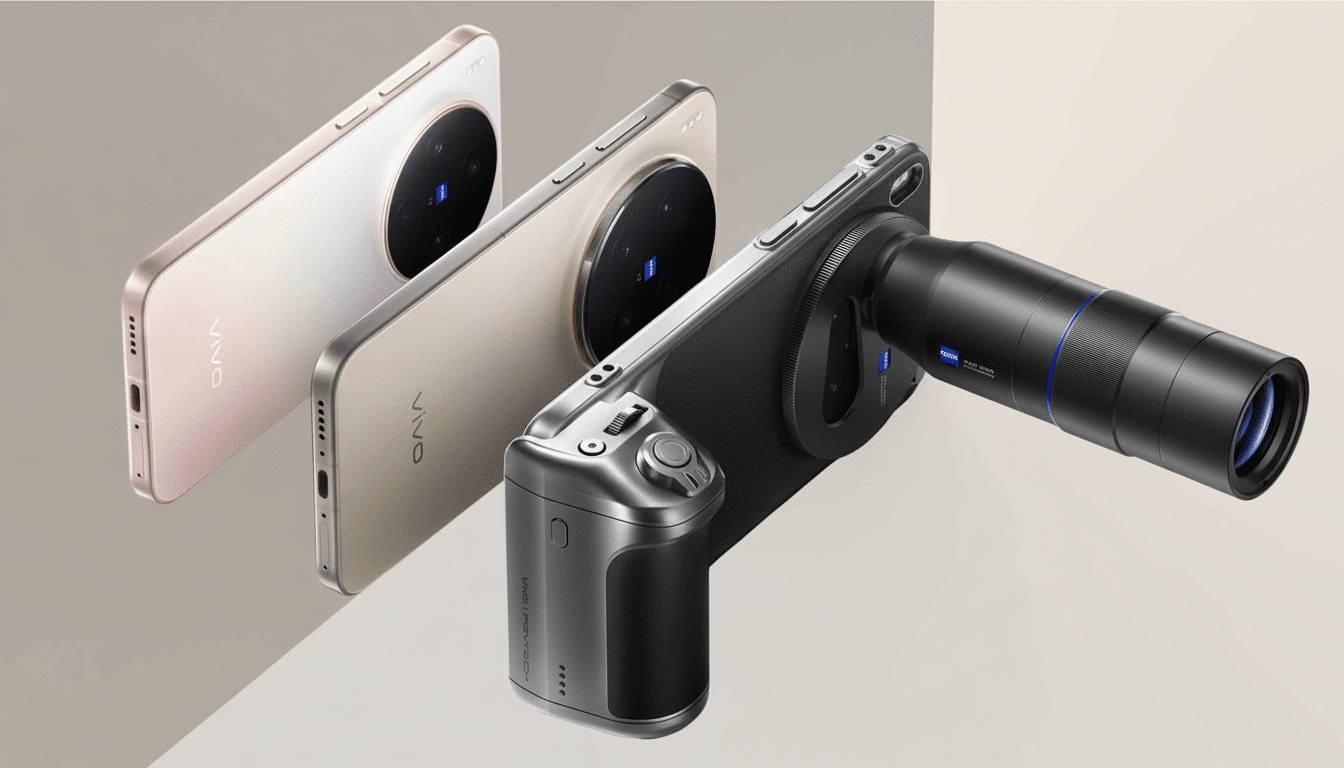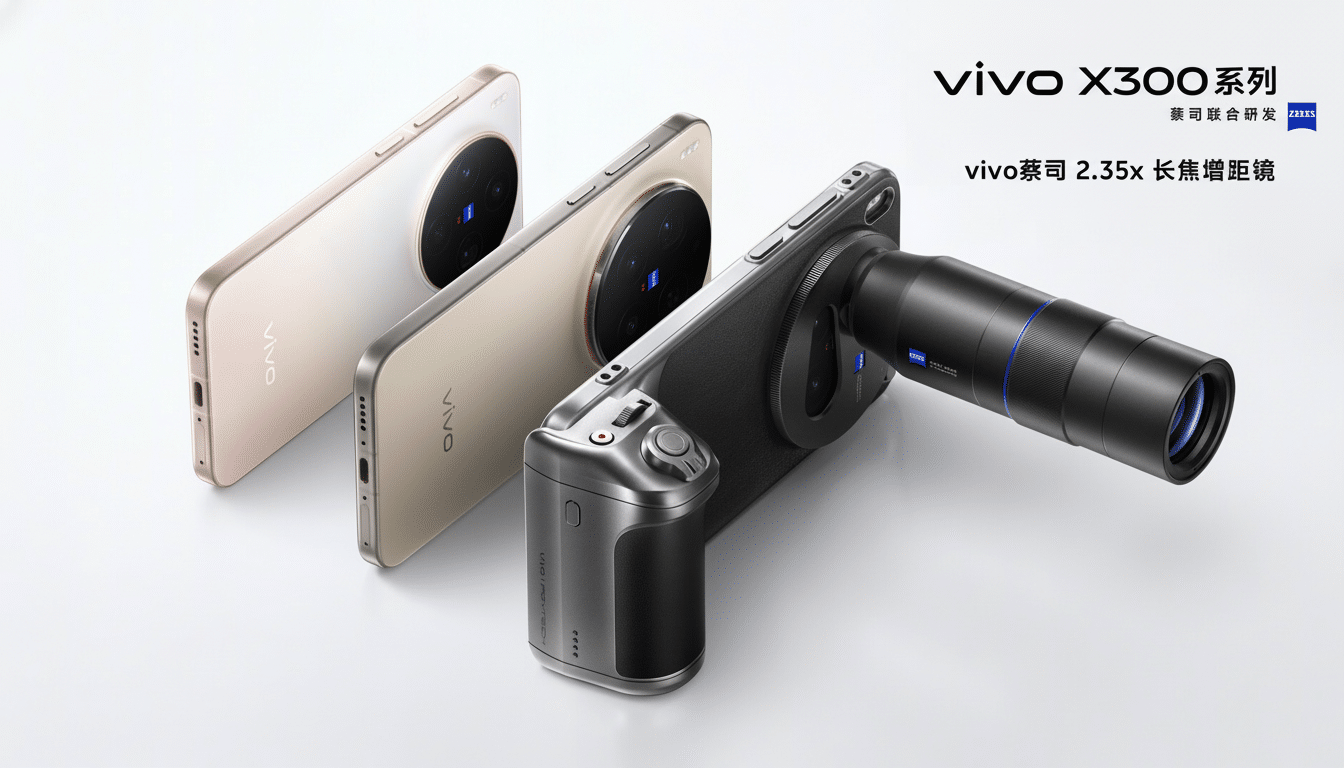One of the year’s standout camera phones has a sequel — and a brief hands-on confirms that its recipe remains heavily focused on imaging.
The chief X300 Pro — and its diminutive X300 counterpart — advance long-range zoom, creator-centric video capabilities, and rugged body construction, introducing a global release plan plus a charming external telephoto option.
- What We Know From Early Testing of Vivo X300 Pro
- Performance, display, and battery life impressions so far
- Video tools for creators and advanced recording modes
- The smaller sibling X300 offers a compact alternative
- Global availability and accessories for both models
- Early verdict on the X300 Pro and its compact sibling

Its predecessor was widely lauded for its telephoto capability and video flexibility. This one takes that further with shared specs between the two models including: a MediaTek Dimensity 9500 platform, IP69 protection from dust and wet environments, and ultra-low 1-nit minimum display brightness. Design-wise, it’s a bit of a modernist square — like most things these days — with rounded corners and the same flat metal all-around; a fishbowl look that my colleagues have been enjoying and remarking on elsewhere with its direct rivals such as the OPPO Find X8 range.
What We Know From Early Testing of Vivo X300 Pro
The X300 Pro’s camera stack is the highlight. You have a 50MP 1/1.28-inch Sony LYT-828 for the primary sensor at a 24mm-equivalent focal length, a 50MP ultrawide (JN1), and a feature-packed Isocell HPB 200MP (85mm periscope) — developed jointly with Samsung. Optical stabilization on the telephoto is rated to CIPA 5.5 — an improvement over last year’s glass buried in a smaller chassis — alongside an f/2.67 aperture.
Detail from the 200MP periscope is good in brief sample tests at native 85mm, colour balance is solid, and sharpening is held back. There may still be some hit-or-miss with tele-macro, depending on distance and lighting, but when it hits, the stroke looks hot. The primary camera retains contrast well without crushing shadows, a generally positive sign that bodes well for the recording of dynamic range.
One significant returner is the external telephoto extender add-on. It turns the Pro’s 85mm periscope into a 200mm-equivalent lens and has been fully integrated into the camera UI as a dedicated toggle. Rather than traditional iterations, it functions across any mode — portrait, high-res 200MP shots, and even LOG video — furthering your creative flexibility.
Performance, display, and battery life impressions so far
There’s also an LTPO OLED panel that measures 6.78 inches diagonally at a resolution of 1,260 x 2,800.
The X300 Pro is the first phone to bear MediaTek’s Dimensity 9500 chip as well. Refresh rates scale smoothly up to 120Hz, and that 1-nit floor is really all you need for comfy late-night reading. IP69 certification is fairly rare in the mainstream flagship space, which means protection not only against immersion, but also powerful water jets — helpful for those who put durability first.

Charging is fast at 90W wired and 40W wireless. The spec sheet lists a 6,510mAh battery for some territories (others get the 5,540mAh pack instead due to local regulatory and transport requirements). Company reps have attributed that variance to regional standards; it’s a nuance to monitor if you’re particularly concerned with the absolute limit for endurance.
Performance: General system responsiveness is a pleasure, but enough stress can push into stability limits. In our brief tests, extended GPU loads resulted in throttling we could see (in line with what independent stress tests such as 3DMark’s loop have reported on some previous devices from this brand). Gamers and power users may want to be mindful of sustained thermals, although typical multitasking and camera use was still buttery.
Video tools for creators and advanced recording modes
Video is a visible realm of ambition. And all three rear cameras can shoot 4K/120fps with Dolby Vision capture, a rare bit of parity between lenses. There’s 4K/60 “cinematic” mode, and the live viewfinder operates at 30fps with post-capture processing, so frame interpolation is presumably in the pipeline. 4K recording is now available in more modes, and LOG recording arrives with finer control for grading.
The smaller sibling X300 offers a compact alternative
Prefer compact? A typical X300, meanwhile, slimlines the footprint with a 6.31-inch LTPO display running at 1,216 x 2,640; it feels in hand like phones including the Xiaomi 15. One deviation comes in the camera array: there’s a 200MP main (named Isocell HPB), a 50MP ultrawide (JN1), not to mention a 50MP periscope (with up to 3x optical; known as LYT-602). The solid 6,040mAh battery is bigger than the Pro’s localized smaller pack, and it maintains 90W wired plus 40W wireless charging, too. Practical features such as USB 3.2 transfer speeds and an ultrasonic in-display fingerprint reader are also included.
Global availability and accessories for both models
A global launch is planned. Both models are on their way to markets like India, Southeast Asia, the Czech Republic, Hungary, Italy, Poland, and Spain, as well as Turkey, Kazakhstan, Mexico, and the UAE. In addition, the X300 Pro is expected to arrive in Chile, Colombia, Egypt, Kenya, Pakistan, Peru, Saudi Arabia, and South Africa. The photography kit — comprising the telephoto extender, case, adapter ring, grip, and shoulder strap — will also be available internationally, with full local information to follow.
Early verdict on the X300 Pro and its compact sibling
The new Pro features a sharper long-zoom camera, more serious creator tools, and an IP69 rating that’s rare in smartphones, and is seemingly on track to remain a benchmark for mobile photography. Provided sustained performance and regional battery inconsistencies are handled well — not to mention a sensible price point — this sequel has every chance of topping year-end camera shortlists again. Meanwhile, the smaller X300 quietly becomes an appealing compact option that doesn’t scrimp on stamina or zoom.

